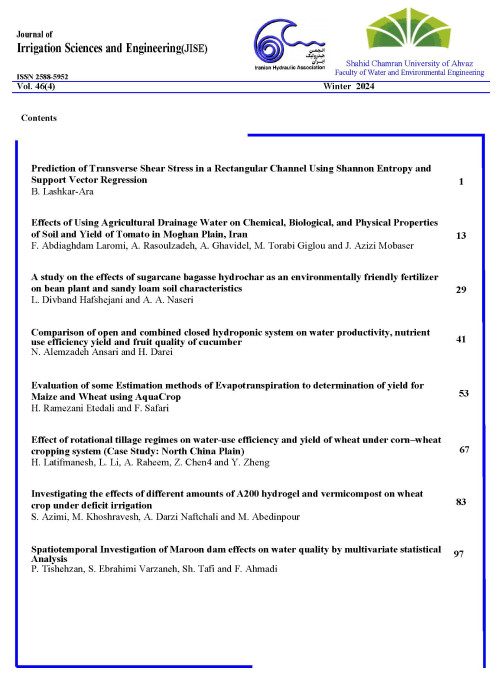Influence of Different Salinities of Groundwater on Salt Rising and Evaporation of the Soil Surface
Author(s):
Abstract:
Shallow groundwater with different quality could be replaced of irrigation water for crop as a cheap water resource in some semi-arid region of world. But salt rising to the root zone due to capillary flow from shallow groundwater is a limiting factor for underground irrigation method. In this study, an experiment in a completely randomized factorial design was conducted with four water treatments include of common water (Gorgan city drink water with 0.6 dS/m of electrical conductivity), 7.5, 12.5 and 17.5 dS/m that were prepared with mixing common water and Caspian Sea water. Two water table treatments also considered include 70 and 100 cm depths. All treatments had 3 replications. Totally 24 lysimeters with 150 cm height and 15 cm diameter were filled with silt clay loam in Gorgan agriculture science and natural recourses university. Ground water injected from some scaled water reservoirs through porous pipes into the soil and water table was created by a floater at stable depth beside of each lysimeter. Soil surface evaporation was measured daily by monitoring the water level changing in each lysimeter reservoir. After a three-month, the water content and electrical conductivity of the saturation extracted samples in four depths including 5, 30, 60 and 90 cm of each soil column were measured. The results of showed that at 1% probability, the rising slat mass in different treatments was significant. In the control treatment, salt accumulation intensity to the soil surface was more than other treatments compare with its groundwater concentration. Comparison of salt rising to the soil surface of treatments for two water tables (70 and 100 cm), showed that the salt rising differences between this two treatments was significant at 1 % probability, and accumulation of salts in the soil profile at 70 centimeters was more than its value at 100 cm water table in all groundwater salinity treatments. Evaporation results showed that the highest evaporation was occurred in 17.5 dS/m salinity treatment. Also as a whole, differences between the evaporation rates of 70 and 100 cm water levels were not significant at 1% probability.
Keywords:
Language:
Persian
Published:
Irrigation Sciences and Engineering, Volume:39 Issue: 1, 2016
Pages:
83 to 91
magiran.com/p1536591
دانلود و مطالعه متن این مقاله با یکی از روشهای زیر امکان پذیر است:
اشتراک شخصی
با عضویت و پرداخت آنلاین حق اشتراک یکساله به مبلغ 1,390,000ريال میتوانید 70 عنوان مطلب دانلود کنید!
اشتراک سازمانی
به کتابخانه دانشگاه یا محل کار خود پیشنهاد کنید تا اشتراک سازمانی این پایگاه را برای دسترسی نامحدود همه کاربران به متن مطالب تهیه نمایند!
توجه!
- حق عضویت دریافتی صرف حمایت از نشریات عضو و نگهداری، تکمیل و توسعه مگیران میشود.
- پرداخت حق اشتراک و دانلود مقالات اجازه بازنشر آن در سایر رسانههای چاپی و دیجیتال را به کاربر نمیدهد.
In order to view content subscription is required
Personal subscription
Subscribe magiran.com for 70 € euros via PayPal and download 70 articles during a year.
Organization subscription
Please contact us to subscribe your university or library for unlimited access!


